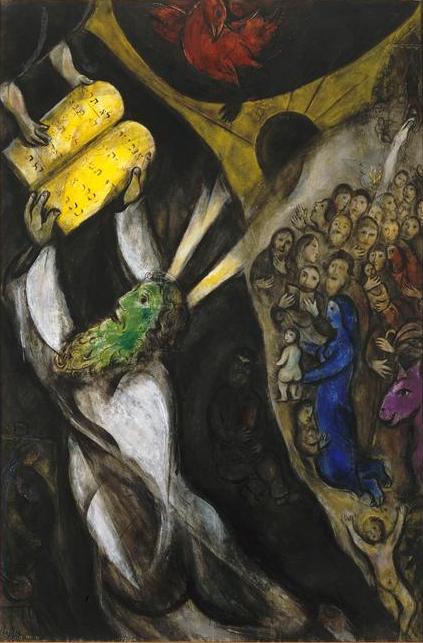
Ancient Hebrews: The Old Testament--The Covenent and the Law

Figure 1.--Marc Zakharovich Chagall (1887-1985) was a leading Russian (Belarus)-French artist. This is his vision of 'Moses receiving the tablets of the Law' (1952). He was a leading modernist artist, experimenting with mny styles and mediums. Few modern srtists focused on religion--Chagall did. Art critic Robert Hughes described Chagall as 'the quintessential Jewish artist of the 20th century'. Chagall saw his work differently--'not the dream of one people but of all humanity'. This of course offends the anti-Semmites, but we believe that he was dead on. Chagall was not the most politically focused. He remained in France during the early phase of the German occupation, but was saved by the American Emergency Rescue Committee (AERC). He and his family left France (May 1941). It was almost to late. The Germans closed down the AERC soon after.
"when it was almost too late",
|
|
The heart of Judaism is the Convenent and the Law and the basic concept influences the other Abrahamic religions. These are among the most important passages in the Torah (Pentateuch). The Covenent is the agreement (essentially a contract) that God concluded with the Old Testament Abraham (Genisus Ch 15 verse 17/ Ch. 17 verse 2,7). It created a special relationship between God and not only Abraham, but also all of his descendents for all time. As a sign of this Convenent he required the rite of Circumcision. The Abrahamitic Covenant was the core of the religious that the descendants of Abraham would develop--Judaism. The people of Yhwh accepted him as the one and only God. Thus Judaism became the first monotheistic religion. The next step in the development of Judaism was the giving of the Law. This according to the Torah was done on Mount Sinai--thus the Sinaitic covenant. It was essentially a renewl of the originl Abrahamic Convenent. God presented the Ten Commandments to Moses. And the people of Israel pledged themselves to keep His covenant (Exodus Ch. 19 verse 8). Moses went up and down Mt. Sianai to make sure the people inderstood and agreed. And the Law in more detailed followed Exodus Ch. 20-23). After the giving of the Law, Moses sprinkled 'the blood of the covenant sacrifice' half upon the people and half upon the altar of the Lord (Exodus Ch. 24, verses 6-8). And to signify this mystical union of Israel and Yhwh, the 'everlasting' Sinaitic covenant between God and Israel became the keeping of the the Sabbath (Exodus Ch. 31, verses 13-17). The tables of the Law upon which the pledge was made became known as 'the book of the covenant' (Exodus Ch. 24, verse 7). The Ten Commandments became known as thge 'the words of the covenant' (Exodus Ch. 34, verse 28). The tables containing the Ten Commandments nd Law became 'the tables of the covenant' (Deuteronomy Ch. 9 verse 9, 15). The Israelis during their wanderings in the wilderness and then after settling in Palestine carried the Ark of the Covenant (Numbers Ch. 10, verse 33 and Deuteronomy Ch. 8 verse 31 and Ch. 31 verse 26). And then constantly throughrout Joshua, Samuel, and Kings) the Ark was regarded as 'testimony' to the presence of the Yhwh and the Covenant in their midst. Notice it was not a graven image (idol), but the Convenent and Law.
Sources
CIH

Navigate the Children in History Website:
[Return to the Main ancient Hebrew: Old Testmant history]
[Return to the Main Ancient Hebrew history]
[About Us]
[Introduction]
[Biographies]
[Chronology]
[Climatology]
[Clothing]
[Disease and Health]
[Economics]
[Freedom]
[Geography]
[History]
[Human Nature]
[Law]
[Nationalism]
[Presidents]
[Religion]
[Royalty]
[Science]
[Social Class]
[Bibliographies]
[Contributions]
[FAQs]
[Glossaries]
[Images]
[Links]
[Registration]
[Tools]
[Children in History Home]
Created: 8:03 PM 11/5/2015
Last updated: 8:04 PM 11/5/2015



